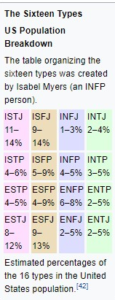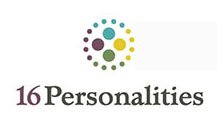An important part of knowing who you are, is getting to know your personality. It gives a clear description of how you would act in certain situations. In this article you will learn what really drives, inspires and worries you. We’ll use the MBTI test to get a indication of your personality type.
Take the MBTI test
Before telling you more about the 16 personality types, take this test to get a indication of your Myers-Briggs Type Indicator. This link will take you to another website, with a test that you can complete within 12 minutes.
I think the results of test will be more accurate if you don’t know about the different types beforehand, otherwise you can already decide which personality type you want to see and answer the questions accordingly to fit this perception.
So…
Do you recognize yourself in the results?
Explanation of MBTI Personality Types
The test you just made has given you a personality type that is indicated with five letters. Each of these letters stands for a personality aspect. You should see each of these aspects as a two-sided scale, with a ‘neutral’ in the middle.
Extraversion (E) – Introversion (I)
This aspect shows how you interact with the world around us. Most people are familiar with the term introvert and extravert, but how they are used in the MBTI is somewhat different:
Introverts are inward-focused. They tend to be thought-oriented and get energy from reflections, feeling and ideas. They can recharge by spending time alone. In social interactions, they prefer a deep, meaningful conversation with a slower pace with time for contemplation and they would rather observe than be in the center of attention.
Extraverts are outward-focused. They tend to be action-oriented and get energy from group activities, fast-paced environments and being around other people. They tend to think out loud and work out ideas with others. Social interactions excite them and they enjoy being at the center of attention.
Sensing (S) – Intuition (N)
The second aspect describes how you see the world and process information:
Sensing (or Observant) people focus on the reality of how things are. They are down-to-earth and focus on the present or past. They pay attention to concrete facts and describe things in a specific, literal way. They enjoy getting hands-on experience and gain a great deal of their information from their five senses.
Intuitive people imagine the possibilities of how things could be. They are very imaginitative, open-minded and curious. They pay attention to the big picture, patterns and concepts. They like to describe things in a figurative, poetic way and prefer novelty over stability.
Thinking (T) – Feeling (F)
This aspect describes how you make decisions.
Thinkers base decisions on an objective analysis. They prioritize logic over emotions and value justice and fairness. Thinkers place a greater emphasis on facts and tend to be consistent, logical and impersonal when weighing a decision. They can be described as reasonable and level-headed.
Feelers base decisions on personal values and how actions affects others. They like to point out the best in people and value harmony and forgiveness. Feelers take people and their emotions into account when weighing a decision. They can be described as warm and empathetic.
Judging (J) – Perceiving (P)
This aspect describes how you tend to deal with the outside world and describes your approach to work and planning.
Judging individuals prefer to have matters settled and be organized. They value clarity, predictability and structure. They make plans and prefer to have detailed step-by-step instructions. They believe that rules and deadline should be respected.
Perceiving (or Prospecting) individuals prefer to leave options open and spot opportunities. They like a more flexible and spontaneous approach and don’t see rules and deadlines as fixed. They are usually good at improvising and making things up as they go. They enjoy surprises and new situations.
Assertive (A) – Turbulent (T)
The 16 Personalities test also gave you a fifth letter, that is not originally part of the MBTI. It is an indicator of how confident you are in your abilities and decisions.
Assertive individuals are self-assured and resistant to stress. They refuse to worry too much and do not push themselves too hard when it comes to achieving goals.
Turbulent individuals are self-conscious and sensitive to stress. They are likely to experience a wide range of emotions and to be success-driven, perfectionistic and eager to improve.
Play the Interactive Story
In the second level of the Game of Life, you are still floating around aimlessly at sea. When you how other people’s lives are smooth sailing, it frustrates you. Everyone seems to have a strong sense of who they are and what they want to do in life.
In a world bursting with personalities, it is easy to forget that you have one yourself. But you remember that you packed a compass in your backpack. As you slide off the cover, your personality gets revealed.
About the MBTI test
The MBTI is loosely based on concepts by psychiatrist Carl Jung, but has since been developed by Katharine Cook Briggs and her daughter Isabel Briggs Myers.

Jung’s hypothesis was that humans have four cognitive functions (thinking, feeling, sensation and intuition), and that each of these functions had an extravert and introvert orientation, resulting in eight dominant functions. The MBTI is based on these eight hypothetical functions, and Briggs and Myers developed these into 16 different personality types.
The validity of Myers-Briggs Type Indicator has faced a lot of criticism. It is not used in psychosocial practice and many of the studies that endorse the MBTI are unscientific, methodologically weak or funded by the sale
s of the MBTI.
So the Myers-Briggs Type Indicator is by no means a scientific analysis of your personality, keep that in mind. But it is a great tool for self-reflection.
Want a more scientific personality test?
The Big Five
A scientifically proven method to assess your personality type. This method is used by academia and shows a better validity than the MBTI test. However, the results are a bit basic and you’ll find it harder to draw conclusions for your personal development.






